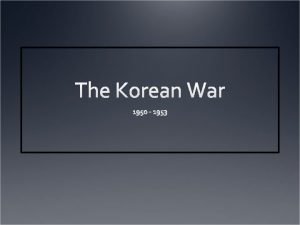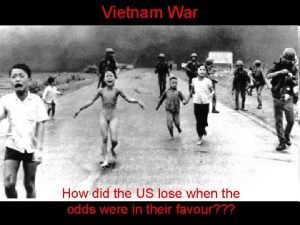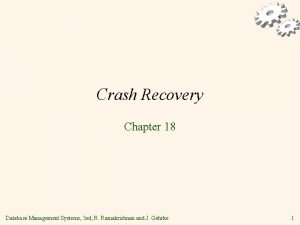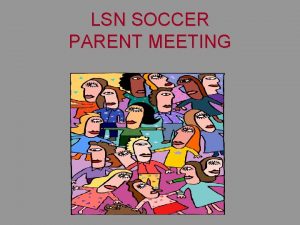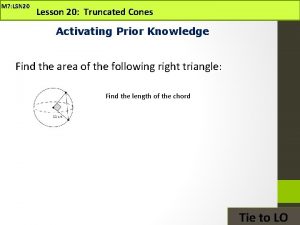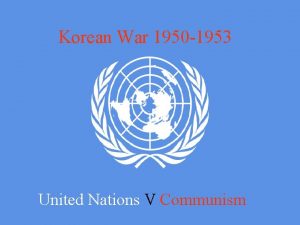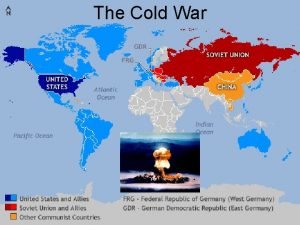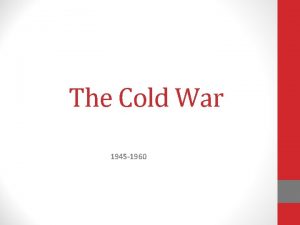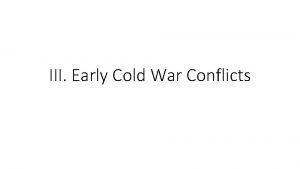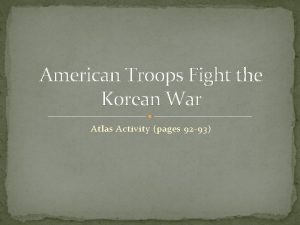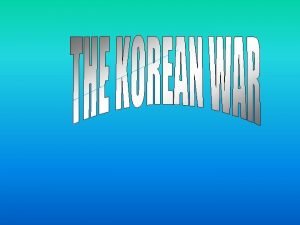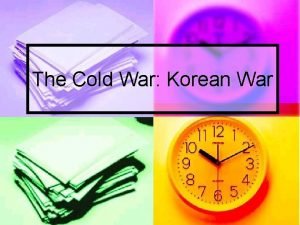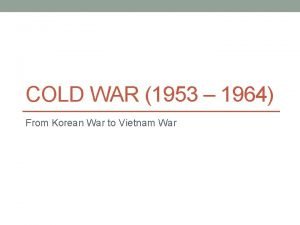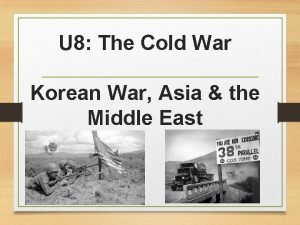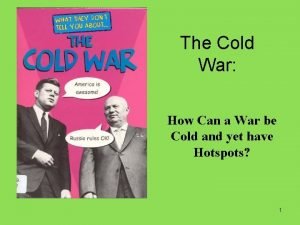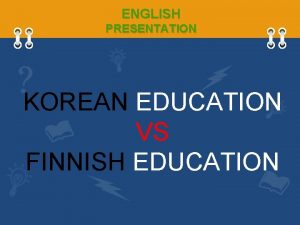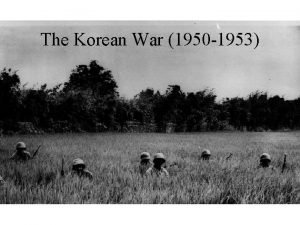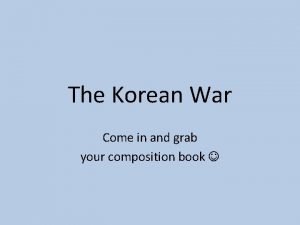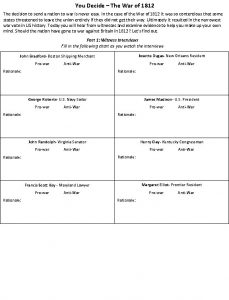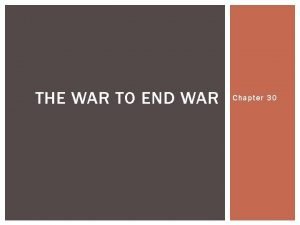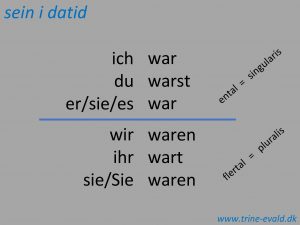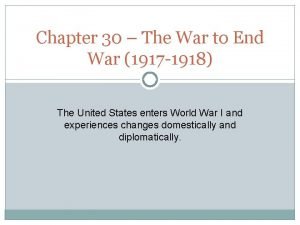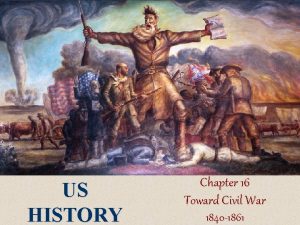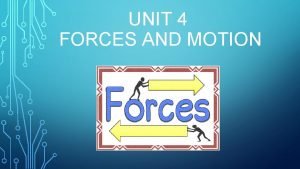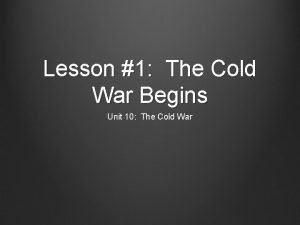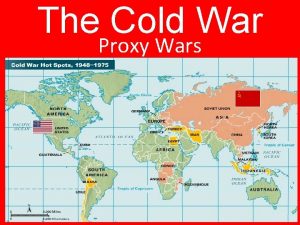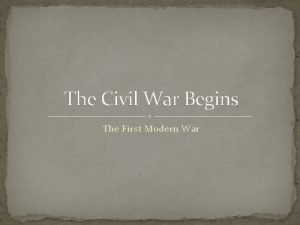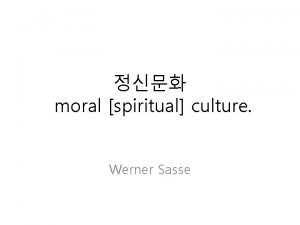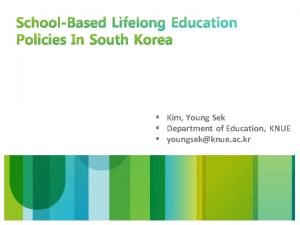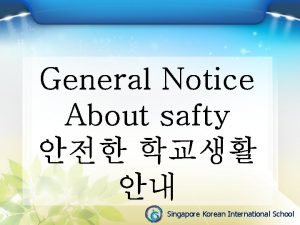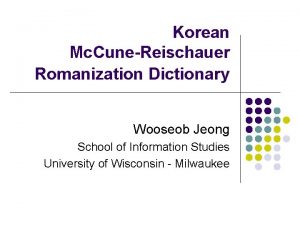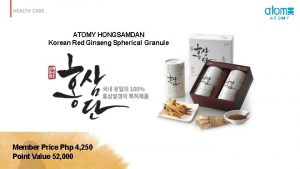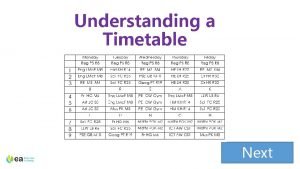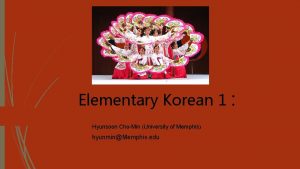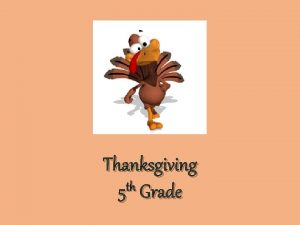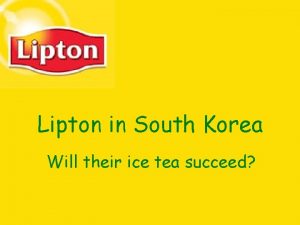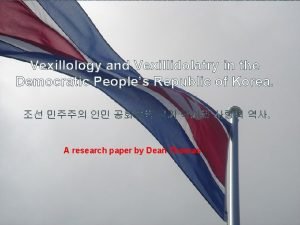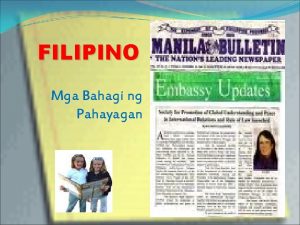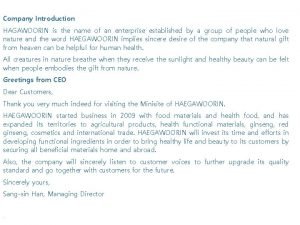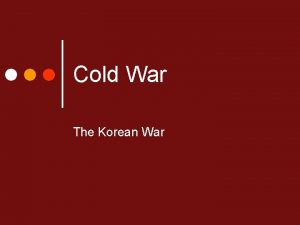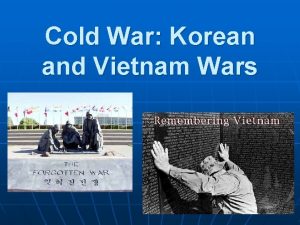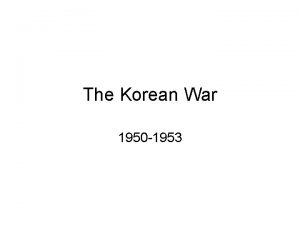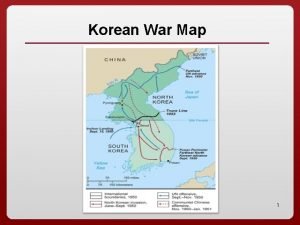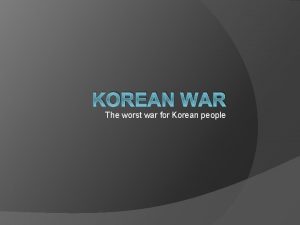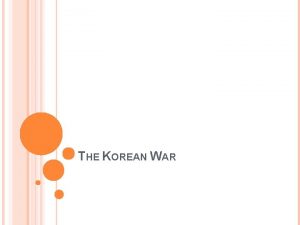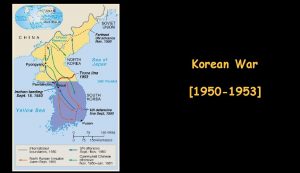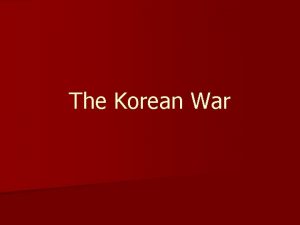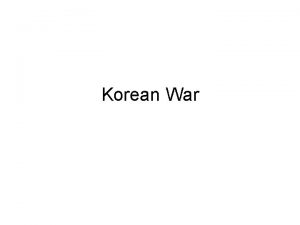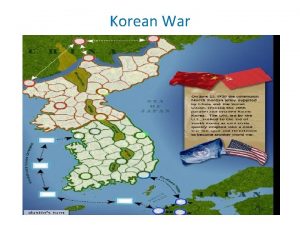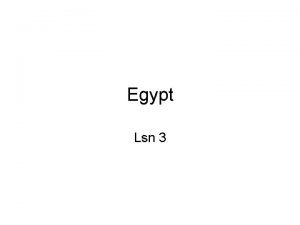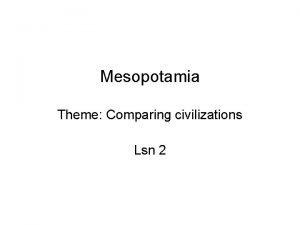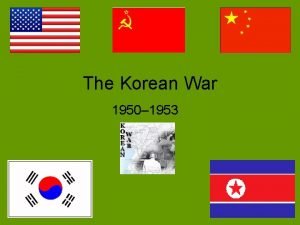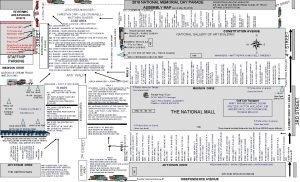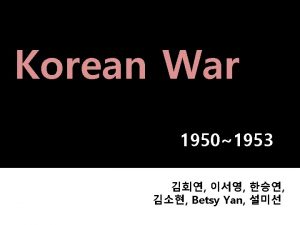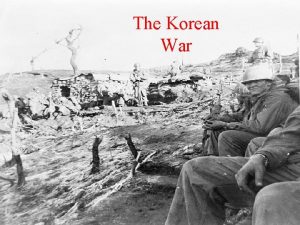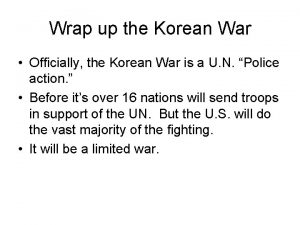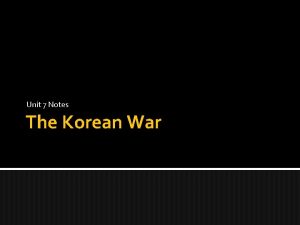Korean War Lsn 29 ID SIG Inchon limited













































- Slides: 45

Korean War Lsn 29

ID & SIG: • Inchon, limited war, Mac. Arthur, Pusan Perimeter, Seoul, Task Force Smith, United Nations, Chinese intervention

Divided Korea • After World War II, Japan’s former colony of Korea was divided into two occupation zones along the 38 th parallel with the Soviet zone in the north and the US zone in the south. • Before the occupation forces departed, an anticommunist regime was established in the south and a communist one in the north.

US in Asia • The US was uncertain as to the extent of its commitment in Asia • It knew its umbrella definitely covered Japan, Okinawa, and the Philippines, but it was unclear about Taiwan, South Korea, and Southeast Asia • Believing the US did not intend to protect South Korea, the USSR allowed the North Koreans to invade the south in 1950 Secretary of State Dean Acheson’s speech to the National Press Club omitted South Korea from the US “defensive perimeter”

North Korea Attacks: June 25, 1950 • North Korean army crossed the 38 th parallel with an invasion force totaling over 90, 000 troops and 150 Soviet-built tanks • By the night of June 28, Seoul had fallen and the South Korean forces were in disarray • South Korea appealed to the United Nations for assistance • The UN passed a resolution recommending that “the members of the United Nations (the US) offer assistance to the Republic of Korea as to repel the armed attack and to restore peace and security to the area. ” • US troops are deployed in Korea

United Nations • As a member of the UN Security Council, the Soviet Union could have vetoed UN involvement in the war, but instead Moscow was boycotting the Security Council at the time in protest of the UN’s failure to seat a representative of the newly established People’s Republic of China • In the absence of the USSR, the UN passed a resolution sending a military force to South Korea • The force was predominately American with Douglas Mac. Arthur as the Supreme Commander – There were also substantial contributions from the UK, Canada and other Commonwealth countries.

Force Comparison • North Korean People’s Army (NKPA) – 14 Divisions (9 in invasion force) – Soviet trained, armed and advised – 150 tanks, almost 100 modern aircraft • U. S. Armed Forces in 1950 – 10 Army divisions (4 in Japan) – 48 USAF air groups – 331 combatants (64 in Pacific) – 2 Marine divisions (-)

Task Force Smith • To stem the North Korea advance, the US deployed “Task Force Smith, ” a delaying force of two reinforced rifle companies to Pusan • Mac. Arthur thought this “arrogant display of strength” would cause the North Koreans to take pause and slow their aggression Elements of Task Force Smith arriving at Taejon

Task Force Smith • Task Force Smith began occupying defensive positions on July 5 at 3: 00 am – At 7: 00 they began seeing enemy movement – At 8: 16 they began firing artillery – At 2: 30 the commander decided to withdraw • When LTC Smith arrived at Ch’onan on July 6, he counted 185 men – He began with 540 • After all stragglers returned, the total loss to TF Smith was 35%

Implications of Task Force Smith • Task Force Smith has become the poster child for the cost of military unpreparedness • “No more Task Force Smiths” – GEN Gordon Sullivan, Army Chief of Staff, 1991 -1995 (administered the post Desert Storm Army downsizing)

“Hollow Army” - World War II peak Army strength was 8, 268, 000 - 89 combat divisions in June 1945 - June 1950 strength was about 591, 000 (1/14 the peak World War II size) - 10 active combat divisions - But to keep them fielded, one battalion from each infantry regiment and one firing battery from each field artillery battalion had been eliminated - This move effectively reduced combat power by 1/3

Far East Command (FEC) • 108, 500 troops under Mac. Arthur • 4 infantry divisions in Japan (7 th, 24 th, 25 th and 1 st Cavalry) • Authorized peacetime divisions strength was 12, 500 (13, 500 for the 25 th ) • Authorized wartime strength was 18, 900 • 3 of the 4 divisions in Japan had about 11, 000 men • In addition to the missing infantry and artillery battalions each • Lacked three anti aircraft artillery batteries • Lacked the regimental tank companies • Had only a company of M 24 Chaffee light tanks in place of the divisional tank battalion • Estimated the divisions could field 62% of normal infantry firepower, 69% of normal anti-aircraft capability, and 14% of armored support

Equipment in FEC • Mostly outdated World War II equipment and much of it was unserviceable – Of 18, 000 jeeps only 8, 000 were serviceable – Of 13, 780 2 1/2 ton trucks, only 4, 441 were serviceable • Had none of the new 3. 5 inch antitank rocker launchers – Only the 2. 36 inch Bazooka which had proved inadequate in 1944 – 1945 • Hydraulic fluid for recoil mechanisms in the M 24 tanks had been on backorder for two years, so most of their 75 mm guns had never been fired • Some men were wearing tennis shoes because of a lack of boots • ¼ of the small arms were defective

Training Problems • Occupation duties took precedence over training • No unit training above the company level had taken place in Eighth Army before April 1949 • Limited maneuver area and an annual personnel turnover rate of 43% impeded training • The four divisions were rated as 65% to 84% combat ready – Some senior officers felt that 40% was more realistic US troops parade across the Yoshida Bridge

Pusan Perimeter: June 27 to Sept 15 • The American forces were unprepared for the North Korean attack • By the end of July, the North Koreans had pushed the U. N. forces to the southeast corner of the peninsula, where they dug in around the port of Pusan.

Inchon (Operation Chromite) Sept 15 • Mac. Arthur completely changed the course of the war overnight by ordering -- over nearly unanimous objections -- an amphibious invasion at the port of Inchon, near Seoul • The Americans quickly gained control of Inchon, recaptured Seoul within days, and cut the North Korean supply lines • American and ROK forces broke out of the Pusan Perimeter and chased the retreating enemy north

Inchon and Selected Principles of War • Surprise – Inchon was an unlikely landing site because of strong tides and mud flats • Maneuver – Amphibious turning movement • Offensive – Had to do something to reverse Pusan situation and gain the initiative • Objective – Landing at Inchon facilitated capture of Seoul; both the South Korean capital and the site of important road and railroad intersections

Elements of Operational Design • • Synergy Simultaneity and depth Anticipation Balance Leverage Timing and tempo Operational reach and approach • • Forces and functions Arranging operations Centers of gravity Direct versus indirect Decisive points Culmination Termination

Inchon and Selected Elements of Operational Design • Operational reach and approach – The distance over which military power can mass effects and be employed decisively. – As the North Koreans moved south, they overextended their lines of communication. – Conversely, shorter American lines of communication allowed the strengthening of the Pusan perimeter.

Inchon and Selected Elements of Operational Design • Culmination – The point in time and space at which an attacker’s combat power no longer exceeds that of the defender – Because of operational reach, by August 23, numerical parity between the two forces north of Pusan was surpassed in favor of the Americans – The NKPA had reached its culminating point while Eighth Army was getting stronger – UN combat forces at this point outnumbered the North Koreans, 92, 000 to 70, 000

Inchon and Selected Elements of Operational Design • Direct versus indirect – Where direct attack means attacking into an opponent’s strength, commanders should seek an indirect approach. – Mac. Arthur’s concept was to “rely upon strategic maneuver to overcome the great odds against me… [T]he alternative is a frontal attack which can only result in a protracted and expensive campaign. ” – Amphibious turning movement

Inchon and Selected Elements of Operational Design • Center of gravity – Those characteristics, capabilities, or sources of power from which a military force derives its freedom of action, physical strength, or will to fight. – If the enemy Co. G was the North Korean People’s Army, how did Operation Chromite succeed when it took place some 140 miles north of the main NPKA forces?

Inchon and Selected Elements of Operational Design • …. . by focusing on a critical vulnerability, the enemy lines of communication • “The vulnerability of the enemy is his supply position. ” – Douglas Mac. Arthur Seoul railroad yards burning after Air Force dropped napalm, September 26, 1950.

Inchon and Selected Elements of Operational Design • Critical vulnerabilities are “critical requirements or components thereof which are deficient, or vulnerable to neutralization, interdiction, or attack (moral/physical harm) in a manner achieving decisive or significant results, disproportional to the military resources applied. ” Bombed North Korean railcars Sept 21, 1950

Inchon and Selected Elements of Operational Design • Decisive points – A point, if retained, that provides a commander with a marked advantage over his opponent. – Seoul was decisive both for its symbolic value as the capital and as the most critical node in the supply line of the enemy attack. Seoul railroad yards burning after Air Force dropped napalm, September 26, 1950

Inchon and Selected Elements of Operational Design • Simultaneity and depth – The simultaneous application of power against key adversary capabilities and sources of strength. – Air Force, Navy, and Marine Air struck targets ranging from the enemy’s strategic marshalling areas to tactical forces – Included both the amphibious turning movement and the breakout from Pusan

Inchon and Selected Elements of Operational Design • Simultaneity and Depth – “The deep envelopment based on surprise, which severs the enemy’s supply lines, is and always has been the most decisive maneuver of war. A short envelopment which fails to envelop and leaves the enemy’s supply system intact merely divides your own forces and can lead to heavy losses and even jeopardy. ” • Douglas Mac. Arthur

Inchon and Selected Elements of Operational Design • Termination – Knowing when to terminate military operations and how to preserve achieved advantages. – Success led Mac. Arthur to continue attack into North Korea; a strategic miscalculation that ultimately led to his relief.

Approaching the Yalu • Mac. Arthur continued to push north, ignoring threats of Chinese intervention • On October 25, the Chinese army attacked after having infiltrated into North Korea • Mac. Arthur launched a great offensive toward the end of November, which he optimistically hoped would end the war in Korea

Counteroffensive • Mac. Arthur's “all-out offensive” to the Yalu had barely begun when the Chinese attacked en masse on the night of November 25 • Roughly 180, 000 Chinese troops shattered the right flank of the U. N. army • U. N. retreat ended about 70 miles below Seoul

Stalemate • U. N. re-recaptured Seoul (the fourth and final time it changed hands) on March 15, and had patrols crossing the 38 th parallel on March 31 • In the meantime, Mac. Arthur had been steadily pushing Washington to remove the restrictions on his forces • Truman declined for fear of widening the war and fired Mac. Arthur for disobeying orders on April 11

Mac. Arthur’s Relief • Mac. Arthur repeatedly made public statements that were contrary to official US policy – In August, he sent a speech to be read to the VFW proposing Formosa’s utility as a base of operations – He suggested that Truman Administration policies were responsible for the retreat of the Eighth Army Mac. Arthur and Truman meet at Wake Island, Oct 14, 1950

Mac. Arthur’s Relief • On Dec 6, 1950, Truman published an executive order– aimed at Mac. Arthur– requiring all government officials to clear their public statements on foreign and military policy with the Administration • Truman planned to use recent military successes to invite the Communists to negotiate • Mac. Arthur broadcast an ultimatum to the enemy which undermined Truman’s authority • Sent a letter to Congressman Joseph Martin further criticizing the Administration

Mac. Arthur’s Relief • “I deeply regret that it becomes my duty as President and Commander in Chief of the United States Military Forces to replace you as Supreme Commander, Allied Powers; Commander in Chief, United Nations Command; Commander in Chief, Far East; and Commanding General United States Army, Far East. You will turn over your commands, effective at once, to Lieutenant General Matthew B. Ridgway. ” “But once war is forced upon us, there is no other alternative than to apply every available means to bring it to a swift end. War's very object is victory, not prolonged indecision. In war there is no substitute for victory. ” Mac. Arthur’s Farewell Address Apr 19, 1951

The End of Mobile War • When Ridgway became Commander in Chief, Far East, Lieutenant General James Van Fleet took command of Eighth Army • The Chinese attacked in April and again in May, but Van Fleet counterattacked • By mid-June 1951, UN forces had regained a line that was for the most part north of the 38 th parallel • This last fighting ended the year-long mobile phase of the war

Negotiation and Stalemate • On June 29, 1951, Ridgway broadcast a message to his Communist counterpart announcing his willingness to negotiate • Eighth Army transitioned to an “active defense” • Made several unsuccessful attempts to break Communist supply line with air and artillery Matthew Ridgway

Negotiation and Stalemate • In spite of the slowdown in major maneuver, both sides expended enormous amounts of effort to solidify their lines in an “outpost war” – Costly seesaw battles like Bloody Ridge, Heartbreak Ridge, and Old Baldy Heartbreak Ridge with Bloody Ridge in background

Negotiation and Stalemate • Negotiations characterized by intransigence, especially on the part of the Communists, that created a stalemated war that proved difficult for a democracy to maintain • POWs a major obstacle – The UN feared mistreatment of repatriated prisoners by the Communists and wanted prisoners to decide for themselves whether or not to return home – The Communists insisted on forced repatriations as was required by the Geneva Convention

Negotiation and Stalemate • A poll by the Red Cross in early April 1952 revealed that of 132, 000 Chinese and North Korean prisoners screened, only 54, 000 North Koreans and 5, 100 Chinese wanted to go home • The Communists accused the UN of influencing the poll and negotiations broke down

Negotiation and Stalemate • A couple of factors combined to bring the war to a close – In early 1953, newly elected President Dwight Eisenhower increased pressure on the Communists by authorizing bombing of dams to flood the North Korean countryside – Eisenhower also made it be known the US was willing to renew fighting at higher levels unless progress was made on the peace talks – On March 5, 1953 Soviet premier Joseph Stalin died which brought on a power struggle in the USSR which forced the Kremlin to focus more on internal affairs

Negotiation and Stalemate • On March 28, 1953 an agreement was reached on the exchange of sick and wounded prisoners and on April 26 negotiations resumed • Ultimately it was decided that prisoners who did not want to return home would be turned over to a neutral commission that would hold them for interview by their respective countries before releasing them • There was one more Communist offensive and an incident in which South Korean President Syngman Rhee released without authorization 25, 000 friendly North Korean prisoners, but finally on July 27, 1953 the armistice was signed

Korean War and the Cold War • Truman put limitations on Mac. Arthur because he had concluded that Korea was not worth risking a third world war • Korea was part of the US policy of containment • The 38 th parallel still separates North and South Korea to this day, tensions between these nations still remains high. General Mac. Arthur wanted more US forces in Korea to invade communist China, he was eventually fired by President Truman.

Post-war Korea • The war ended with an armistice, not a peace treaty • The Demilitarized Zone (DMZ) encompasses 2 kilometers on either side of the 151 mile long Military Demarcation Line (MDL) • Throughout the Cold War tensions along the DMZ remained high including an incident in 1976 in which two US Army officers were murdered by North Koreans as the Americans tried to cut down a tree that was obstructing the line of sight between two UN checkpoints

Korea Today • North Korea remains communist and a nuclear threat – Its nickname, the “Hermit Kingdom” reflects the closed nature of its society • South Korea is a fully functioning modern democracy with an economy over 14 times greater than North Korea’s Panmunjom is the official diplomatic headquarters at the DMZ. North Korean guards, in brown, face their South Korean counterparts, in blue.

Next • Student Presentations • Vietnam
 Inchon invasion map
Inchon invasion map Inchon invasion map
Inchon invasion map Vietnam war
Vietnam war Comparing reconstruction plans venn diagram
Comparing reconstruction plans venn diagram Recovery concepts in dbms
Recovery concepts in dbms Lsn soccer
Lsn soccer Lsn 20
Lsn 20 Ficks law
Ficks law Korean war
Korean war Cause of korean war
Cause of korean war What were the causes of the korean war
What were the causes of the korean war Effects of cold war
Effects of cold war Korean war
Korean war American troops fight the korean war 48a answer key
American troops fight the korean war 48a answer key What was the cause of korean war
What was the cause of korean war Rollback korean war
Rollback korean war Korean war map activity answers
Korean war map activity answers The korean war
The korean war Korean war webquest
Korean war webquest Causes of korean war
Causes of korean war Finnish korean war
Finnish korean war Korean war
Korean war Causes of the korean war
Causes of the korean war Why was josette dugas for the war of 1812
Why was josette dugas for the war of 1812 Chapter 30 the war to end war
Chapter 30 the war to end war Simple past bringen
Simple past bringen Sein i datid
Sein i datid Chapter 30 the war to end war
Chapter 30 the war to end war War at home and abroad madison
War at home and abroad madison Toward civil war lesson 3 secession and war
Toward civil war lesson 3 secession and war Studyjams force and motion
Studyjams force and motion The cold war begins lesson 1
The cold war begins lesson 1 Cold war proxy
Cold war proxy Why was the civil war considered the first modern war
Why was the civil war considered the first modern war Werner sasse
Werner sasse Korean to sek
Korean to sek Singapore korean school
Singapore korean school Korean national mc
Korean national mc Atomy korean red ginseng
Atomy korean red ginseng Verb conjugation korean
Verb conjugation korean Korean word order
Korean word order Korean thanksgiving traditions
Korean thanksgiving traditions Lipton korea
Lipton korea Korean people's army
Korean people's army Mga bahagi ng dyaryo sa tagalog
Mga bahagi ng dyaryo sa tagalog Korean taekuk honeyed ginseng
Korean taekuk honeyed ginseng
